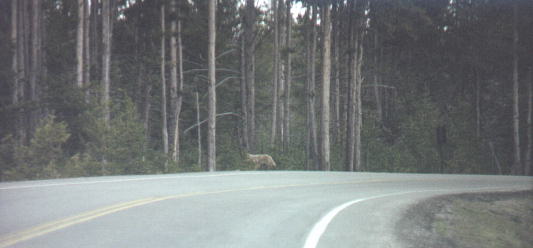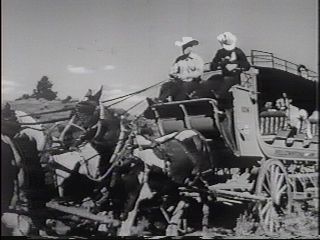

 On August 30, 1878, a horse-drawn wagon pulled onto the
sinter shelf near Old Faithful in the Upper Geyser Basin. While it
is true that Native Americans, mountain men, prospectors,
explorers, and some hardy park tourists had already visited this
area, park superintendent Philetus W. Norris (the leader of the
crew of men accompanying the wagon) was well aware that this
was the first wheeled vehicle to penetrate so far into
Yellowstone's wilderness.
On August 30, 1878, a horse-drawn wagon pulled onto the
sinter shelf near Old Faithful in the Upper Geyser Basin. While it
is true that Native Americans, mountain men, prospectors,
explorers, and some hardy park tourists had already visited this
area, park superintendent Philetus W. Norris (the leader of the
crew of men accompanying the wagon) was well aware that this
was the first wheeled vehicle to penetrate so far into
Yellowstone's wilderness.
When Yellowstone was created in 1872, many in Congress were skeptical of the entire idea of national parks. But, these skeptics were convinced to create the nation's first national park, in part, by the promise that no budget would be necessary to run it. Park proponents believed that enough funds would be generated by leasing land to concesssioners to provide all the money necessary for road construction and maintenance. However, the difficulties inherent in operating businesses that have no roads to them resulted in the failure of the park's first superintendent, Nathaniel P. Langford, to build any access roads into the park.
The arrival of Superintendent Norris in 1878 was the first of many turning points for public access to Yellowstone. Norris was able to convince Congress to provide funds for the new park, including money for the construction of roads. The funding was not lavish by any means, leaving historian Aubrey Haines to remark that it was a "marvel" that Norris "accomplished so much with so little." During Norris' tenure, the miles of roads in Yellowstone increased from 32 to 153 (and trail mileage jumped from 108 to 204). However, the term "road" was loosely applied to these early paths in the park, as tree stumps were routinely cut off just low enough for a wagon to pass over and side hills were graded either minimally or not at all. But, at least there was now a way to passably get into the new park. By the time Superintendent Norris left the park in 1882, the beginning of today's Grand Loop Road system was clearly recognizable.
In 1883, the Congressional bill that provided funds for Yellowstone dictated that "the balance of the sum appropriated to be expended in the construction and improvement of suitable roads and bridges within said park, under supervision and direction of an engineer officer detailed by the Secretary of War for that purpose." Thus, began the long association between the military, beginning with the U.S. Army Corps of Engineers, and Yellowstone National Park. The Corps of Engineers assigned Lieutenant Dan C. Kingman to Yellowstone. He arrived in the park August 13 and immediately set to work hiring construction crews and planning road improvements. While accomplishing many things, he is best remembered for providing a new and easier route south from Mammoth Hot Springs, which bypassed the old route over Snow Pass in favor of a lesser grade through the canyon of Glen Creek. His original wooden trestle that made the route possible has been replaced several times (the current concrete bridge dates from 1977). Today, the canyon is referred to as the Golden Gate.
 After Lieutenant Kingman was transferred to other duties in
1887, work on the park's roads languished for a few years until
the arrival in 1891 of Yellowstone's greatest road builder,
Lieutenant (later Captain) Hiram M. Chittenden of the U.S.
Army Corps of Engineers. Chittenden's time in Yellowstone
spanned two decades and included two different tours of duty.
He completed the figure-eight shaped Grand Loop Road system
begun by Norris and Kingman and still used in the park today.
Chittenden also constructed a road over the top of Mount
Washburn that was used by stagecoaches and, later, automobiles
until the end of World War II; since that time the road has been
one of the most popular hiking trails in Yellowstone. His
construction of a concrete bridge over the Yellowstone River at
the Grand Canyon, accomplished with a single pouring of
concrete during a period of 48 hours, has been called by some
the greatest engineering accomplishment in the history of the
park.
After Lieutenant Kingman was transferred to other duties in
1887, work on the park's roads languished for a few years until
the arrival in 1891 of Yellowstone's greatest road builder,
Lieutenant (later Captain) Hiram M. Chittenden of the U.S.
Army Corps of Engineers. Chittenden's time in Yellowstone
spanned two decades and included two different tours of duty.
He completed the figure-eight shaped Grand Loop Road system
begun by Norris and Kingman and still used in the park today.
Chittenden also constructed a road over the top of Mount
Washburn that was used by stagecoaches and, later, automobiles
until the end of World War II; since that time the road has been
one of the most popular hiking trails in Yellowstone. His
construction of a concrete bridge over the Yellowstone River at
the Grand Canyon, accomplished with a single pouring of
concrete during a period of 48 hours, has been called by some
the greatest engineering accomplishment in the history of the
park.
Unfortunately, the maintenance of the park's roads has been an enduringly difficult task. Long winters with heavy snow accumulations and severe cold followed by rapid spring melts have battered park roads from historic times to the present. Because many of Yellowstone's current roads are simply pavement placed over the older wagon roads, no proper road base work or drainage design was ever done. Consequently, Yellowstone's roads were not meant for today's types, weights, size, and numbers of vehicles. Current road rebuilding efforts in the park are part of a multi-year plan to improve and completely reconstruct the main park road system. Because of sensitive resource issues, short construction seasons, and the need to keep the roads open for visitors during construction, this road rebuilding process will go on for many years. While it is true that construction delays often try visitors' patience, this work is part of a process that for 125 years has kept Yellowstone National Park accessible to the public.
![]() Comments
and Questions are Welcome.
Comments
and Questions are Welcome.
This site is hosted by Geocities. Get your own Free Homepage.